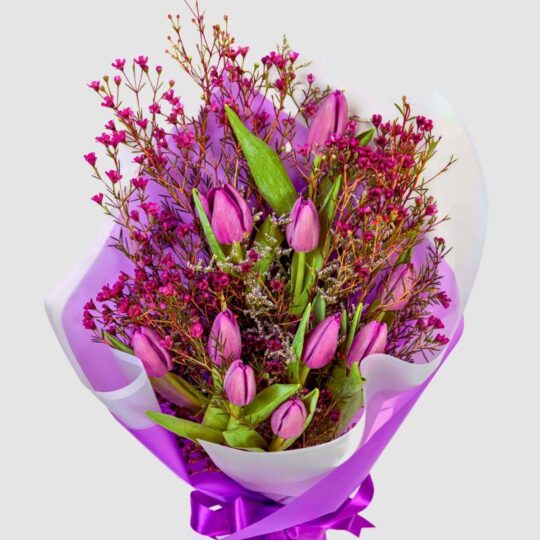Indoor Plants – Golden Tips for EnhancingYour Space with Blooms and Beauty
In This Article
Consider Reading..
Consider Buying

Indoor plants have long been valued for their ability to add a touch of greenery and vitality to interior spaces. Among the myriad options available, flowering houseplants stand out for their captivating blooms that not only beautify our surroundings but also offer a host of other benefits. From improving air quality to boosting mood and productivity, these floral gems bring nature’s splendor indoors in a remarkable way.
Aesthetic Appeal of Indoor Plants
One of the most obvious reasons for incorporating flowering indoor plants into indoor décor is their sheer visual appeal. From delicate orchids to vibrant African violets, these plants come in a dazzling array of colors, shapes, and sizes, allowing homeowners to select varieties that complement their interior design scheme. Whether adorning windowsills, tabletops, or hanging baskets, flowering houseplants infuse living spaces with an undeniable charm and elegance.
Improved Air Quality with Indoor Plants
Beyond their ornamental value, flowering indoor plants also play a vital role in purifying indoor air. Through a process known as photosynthesis, plants absorb carbon dioxide and release oxygen, thereby freshening up the air we breathe. Additionally, certain houseplants, such as peace lilies and spider plants, are particularly effective at filtering out common indoor pollutants like formaldehyde, benzene, and trichloroethylene, thus contributing to a healthier indoor environment.
-
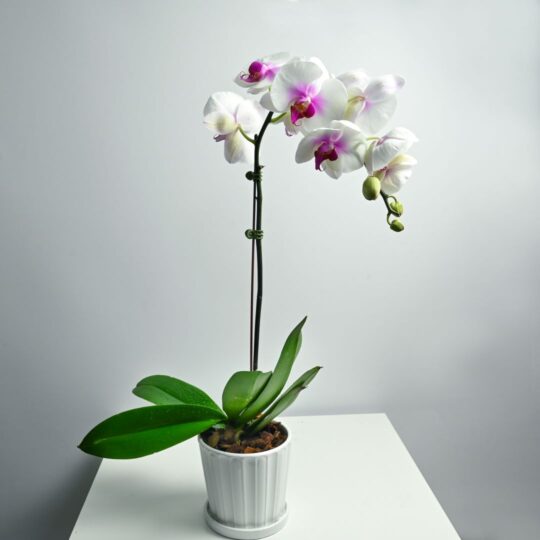 White with pink spots Orchid Phalaenopsis – Single Desktop PlantAED 120.00 – AED 170.00
White with pink spots Orchid Phalaenopsis – Single Desktop PlantAED 120.00 – AED 170.00 -
 Tangerine Orchid Phalaenopsis Dwarf – Single Desktop PlantAED 120.00 – AED 170.00
Tangerine Orchid Phalaenopsis Dwarf – Single Desktop PlantAED 120.00 – AED 170.00 -
 White Orchid Phalaenopsis – Single Desktop PlantAED 120.00 – AED 170.00
White Orchid Phalaenopsis – Single Desktop PlantAED 120.00 – AED 170.00 -
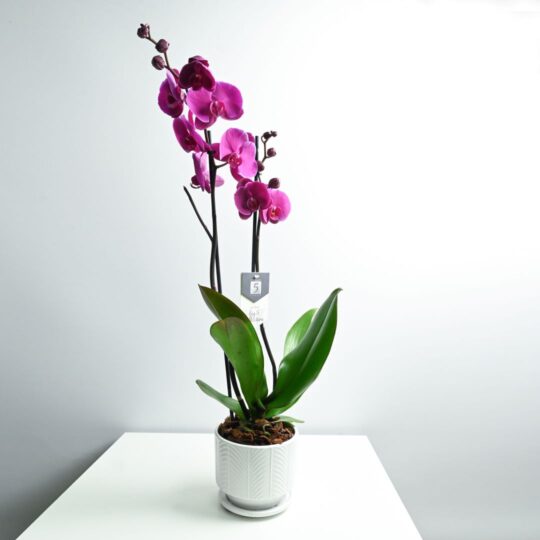 Double Purple Orchid PhalaenopsisAED 120.00 – AED 170.00
Double Purple Orchid PhalaenopsisAED 120.00 – AED 170.00 -
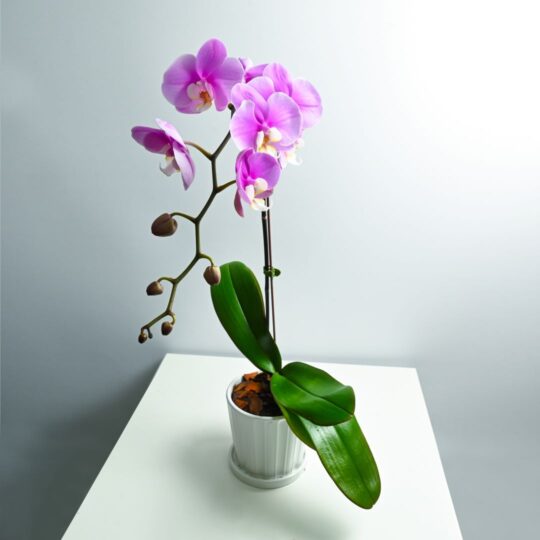 Pink Orchid Phalaenopsis – Single Desktop PlantAED 120.00 – AED 170.00
Pink Orchid Phalaenopsis – Single Desktop PlantAED 120.00 – AED 170.00 -
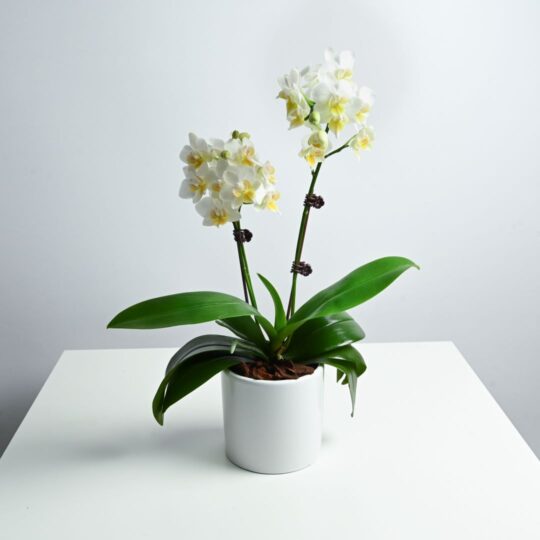 Double White Orchid Phalaenopsis DwarfAED 120.00 – AED 170.00
Double White Orchid Phalaenopsis DwarfAED 120.00 – AED 170.00 -
 Double White Orchid PhalaenopsisAED 120.00 – AED 170.00
Double White Orchid PhalaenopsisAED 120.00 – AED 170.00 -
 Summer Song Orchid (Phalaenopsis Dwarf Double)AED 120.00 – AED 170.00
Summer Song Orchid (Phalaenopsis Dwarf Double)AED 120.00 – AED 170.00 -
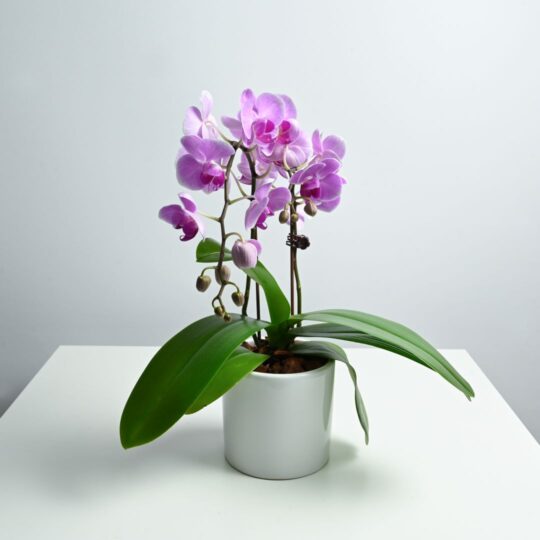 Pink Lucky Girl Orchid (Phalaenopsis Dwarf Double)AED 120.00 – AED 170.00
Pink Lucky Girl Orchid (Phalaenopsis Dwarf Double)AED 120.00 – AED 170.00
Stress Reduction and Well-being with Indoor Plants
Numerous studies have demonstrated the positive impact of indoor plants on human well-being, with flowering varieties offering unique benefits. The presence of flowers has been shown to evoke feelings of happiness, calmness, and relaxation, making them ideal additions to spaces where stress and anxiety may be prevalent. Whether placed in bedrooms, home offices, or living areas, flowering houseplants have a tranquilizing effect that can help alleviate the pressures of modern life.
Improve Productivity and Creativity with Indoor Plants
In addition to promoting relaxation, flowering indoor plants have been linked to enhanced productivity and creativity. Research indicates that exposure to natural elements, including plants and flowers, can stimulate cognitive function and improve concentration levels. By creating a more stimulating and visually engaging environment, flowering houseplants can inspire creativity and innovation, making them valuable assets in both home and work settings.
Low Maintenance Options
Contrary to popular belief, many flowering indoor plants are relatively low maintenance and well-suited for indoor cultivation. While specific care requirements may vary depending on the species, most flowering plants thrive in moderate to bright indirect light and require regular watering and occasional fertilization. With proper attention and care, these plants can grace indoor spaces with their blossoms for extended periods, rewarding owners with continuous beauty and enjoyment.
Popular Flowering Indoor Houseplants
When it comes to selecting flowering houseplants for indoor display, there are countless options to choose from. Some popular varieties include:
- Orchids: Known for their exquisite blooms and elegant appearance, orchids add a touch of luxury to any space.
- African Violets: With their vibrant flowers and compact growth habit, African violets are perfect for windowsills and tabletops.
- Peace Lilies: Renowned for their striking white blooms and air-purifying qualities, peace lilies thrive in low to moderate light conditions.
- Anthuriums: Characterized by their glossy foliage and vibrant spathes, anthuriums are prized for their long-lasting flowers.
- Bromeliads: Featuring colorful bracts and exotic foliage, bromeliads make eye-catching additions to indoor gardens and terrariums.
Incorporating flowering indoor plants into indoor spaces is a simple yet effective way to enhance aesthetics, improve air quality, and promote overall well-being. With their captivating blooms and myriad benefits, these plants have the power to transform any interior into a verdant sanctuary of beauty and tranquility. Whether adorning a cozy corner or serving as a focal point in a room, flowering houseplants are sure to delight the senses and uplift the spirits of those who encounter them.
Care Tips for Flowering Indoor Houseplants
While flowering houseplants can bring joy and beauty into your home, it’s essential to provide them with the proper care to ensure they thrive. Here are some essential tips for keeping your flowering plants healthy and vibrant:
- Light Requirements: Most flowering houseplants prefer bright, indirect light. Place them near a window where they can receive plenty of natural light without being exposed to direct sunlight, which can scorch their delicate blooms and foliage.
- Watering: Proper watering is crucial for the health of flowering houseplants. Check the soil moisture regularly and water when the top inch of soil feels dry to the touch. Avoid overwatering, as it can lead to root rot, but also ensure that the plants don’t dry out completely, as this can cause their flowers to wilt prematurely.
- Humidity: Many flowering houseplants, such as orchids and African violets, benefit from increased humidity levels. You can increase humidity around your plants by placing them on a tray filled with pebbles and water or by using a room humidifier.
- Temperature: Flowering houseplants generally prefer temperatures between 65°F and 75°F during the day and slightly cooler temperatures at night. Avoid placing them near drafty windows or heating vents, as extreme temperature fluctuations can stress the plants.
- Fertilization: Feed your flowering houseplants regularly during the growing season (usually spring and summer) with a balanced, water-soluble fertilizer diluted to half-strength. Reduce or stop fertilizing during the plant’s dormant period in fall and winter.
- Pruning and Deadheading: Remove spent flowers and yellowing or dead leaves regularly to encourage new growth and prolong the blooming period. Use clean, sharp scissors or pruning shears to make clean cuts and prevent damage to the plant.
- Potting and Repotting: Repot your flowering houseplants into slightly larger containers with fresh potting soil every 1-2 years or when they outgrow their current pots. Choose pots with drainage holes to prevent waterlogged soil, which can lead to root rot.
- Pest Control: Keep an eye out for common indoor plant pests like aphids, mealybugs, and spider mites, especially during the warmer months. If you notice any signs of infestation, treat the affected plants promptly with insecticidal soap or horticultural oil.
By following these care tips and providing your flowering houseplants with the attention they need, you can enjoy their beauty and benefits for years to come. Whether you’re a seasoned plant enthusiast or a novice gardener, incorporating these stunning blooms into your indoor space is sure to bring joy and satisfaction.
Care Tips for Flowering Houseplants
While flowering indoor plants offer numerous benefits and aesthetic appeal, proper care is essential to ensure they thrive and continue to bloom abundantly. Here are some key tips to help you maintain healthy and vibrant flowering houseplants:
- Light Requirements: Most flowering houseplants prefer bright, indirect light. Place them near windows where they can receive ample sunlight without being exposed to direct rays, which can scorch their delicate foliage and flowers.
- Watering: Establish a consistent watering schedule based on the specific needs of each plant. While it’s crucial to keep the soil evenly moist, avoid overwatering, as this can lead to root rot. Allow the top inch of soil to dry out slightly between waterings.
- Humidity: Flowering houseplants, especially tropical varieties, thrive in humid environments. Increase humidity levels by misting the foliage regularly or placing a tray filled with water and pebbles beneath the plant’s container.
- Temperature: Maintain moderate temperatures for your flowering houseplants, avoiding extremes of heat or cold. Most varieties prefer temperatures between 65°F to 75°F (18°C to 24°C) during the day and slightly cooler temperatures at night.
- Fertilization: Feed your flowering houseplants with a balanced, water-soluble fertilizer during the growing season (spring and summer) to promote healthy growth and abundant blooms. Follow the manufacturer’s instructions for dilution and frequency of application.
- Pruning and Deadheading: Remove spent flowers regularly to encourage continuous blooming and prevent the plant from expending energy on seed production. Additionally, prune away any yellowing or dead foliage to maintain the plant’s overall health and appearance.
- Potting Mix: Use a well-draining potting mix formulated specifically for flowering houseplants to ensure optimal root health and moisture retention. Repot the plant as needed to provide ample space for root growth.
- Pest and Disease Control: Monitor your flowering houseplants regularly for signs of pests such as aphids, mealybugs, and spider mites. If detected, treat the infestation promptly using natural or chemical remedies to prevent damage to the plant.
By following these care guidelines and providing your flowering houseplants with the attention they need, you can enjoy their beauty and benefits for years to come. Remember to observe your plants closely and adjust care routines as necessary to accommodate their individual requirements and growing conditions.
Flowering houseplants are more than just decorative accents; they are living companions that enrich our indoor spaces with their beauty, fragrance, and vitality.
Whether you’re a seasoned indoor plant enthusiast or a novice gardener, incorporating these botanical treasures into your home will undoubtedly bring joy, tranquility, and a connection to the natural world. With proper care and attention, your flowering houseplants will flourish, creating a welcoming and rejuvenating sanctuary that you’ll delight in every day.
Seasonal Blooms
Different flowering indoor plants exhibit their blooms at various times of the year, adding seasonal charm to indoor spaces. Understanding the natural flowering cycles of your plants allows you to anticipate when they will be in full bloom, enhancing the visual interest of your home throughout the year. Additionally, incorporating a variety of plants with staggered blooming periods ensures a continuous display of color and fragrance.
Propagation Techniques
Many flowering indoor plants can be propagated through simple techniques such as stem cuttings, division, or seed sowing. Learning how to propagate your plants not only allows you to expand your collection inexpensively but also gives you a deeper appreciation for the lifecycle of your botanical companions. Experimenting with propagation methods can be a rewarding journey, offering insights into plant growth and development.
Specialized Care for Specific Varieties
Each type of flowering indoor plant has its own unique care requirements and preferences. Some plants may thrive in bright, indirect light, while others prefer lower light conditions. Similarly, certain species may require higher humidity levels or specific temperature ranges to flourish. Understanding the specific needs of your plants enables you to tailor your care routine accordingly, maximizing their health and longevity.
Creative Display Ideas in Indoor Plants
Beyond traditional pots and planters, there are numerous creative ways to display flowering houseplants in indoor spaces. Consider incorporating hanging baskets, terrariums, wall-mounted planters, or decorative containers to showcase your plants in unique and eye-catching arrangements. Experimenting with different display options adds visual interest and personality to your home decor while highlighting the natural beauty of your flowering houseplants.
Cultivating a Green Thumb
Caring for flowering indoor plants is not only about providing the necessary light, water, and nutrients but also about cultivating a deeper connection with nature. Observing your plants closely, noticing changes in growth patterns, and responding to their needs fosters a sense of mindfulness and attentiveness. As you develop your green thumb, you’ll develop a symbiotic relationship with your plants, nurturing them as they enrich your indoor environment.
Flowering houseplants are more than just decorative accents; they are living expressions of beauty, resilience, and growth. By embracing the diversity of flowering houseplants and integrating them into our indoor spaces, we invite the transformative power of nature into our daily lives. Whether you’re a seasoned plant enthusiast or a novice gardener, the journey of caring for flowering houseplants is one filled with discovery, joy, and connection to the natural world. So, let’s continue to nurture and celebrate these botanical treasures, enriching our homes and hearts in the process.
Benefits of Flowering Houseplants
Stress Reduction and Mood Enhancement: The presence of flowering houseplants has been shown to reduce stress levels and promote feelings of well-being. Their vibrant blooms and lush foliage create a soothing and uplifting environment, helping to alleviate tension and anxiety.
Natural Air Purification: Flowering indoor plants, like all plants, absorb carbon dioxide and release oxygen during photosynthesis. In addition to this vital function, many flowering varieties also possess air-purifying qualities, filtering out harmful toxins and pollutants from the air, thus improving indoor air quality.
Biophilic Connection: Flowering houseplants foster a connection to nature, even in urban environments where access to green spaces may be limited. This biophilic connection has been associated with improved mental health, cognitive function, and overall quality of life.
Decorative Versatility: Flowering indoor plants offer endless decorative possibilities, enhancing any interior space with their beauty and charm. Whether showcased in traditional pots, hanging baskets, or decorative containers, they add a pop of color and texture to home decor, creating visually appealing focal points.
Tips for Selecting Flowering indoor plants
Consider Light Conditions: Assess the lighting conditions in your home before selecting flowering houseplants. Choose varieties that match the available light levels, whether it’s bright, indirect light for sun-loving blooms or lower light for shade-tolerant species.
Evaluate Maintenance Needs: Be realistic about the time and effort you can devote to indoor plant care. Select flowering houseplants with care requirements that align with your lifestyle and schedule. Opt for low-maintenance varieties if you’re a beginner or have limited time for plant care.
Research Bloom Times: Different flowering indoor plants bloom at different times of the year. Consider selecting varieties with staggered bloom times to ensure year-round floral displays and continuous visual interest in your indoor space.
Inspect Plant Health: Before purchasing flowering indoor plants, thoroughly inspect them for signs of pests, diseases, or stress. Choose plants with healthy foliage, sturdy stems, and vibrant blooms to ensure they have the best chance of thriving in your home.
Advanced Care Techniques for Indoor Plants
For seasoned plant enthusiasts looking to take their flowering houseplant care to the next level, here are some advanced techniques to consider:
Propagation of Indoor Plants: Learn how to propagate your flowering indoor plants through methods such as stem cuttings, division, or air layering. Propagation allows you to expand your plant collection, share plants with friends, and rejuvenate older specimens.
Training and Pruning: Explore techniques for training and shaping flowering houseplants to enhance their aesthetic appeal. Regular pruning can promote bushier growth, remove dead or damaged foliage, and encourage prolific blooming.
Seasonal Care Adjustments: Adapt your care routine to the changing seasons, providing appropriate light, temperature, and moisture levels as needed. Adjust fertilization schedules and watering frequency to reflect seasonal changes in plant growth and dormancy.
Disease Prevention and Treatment: Educate yourself about common pests and diseases that affect flowering houseplants and implement preventive measures to minimize their impact. Familiarize yourself with organic and chemical treatment options to address pest infestations or fungal infections promptly.
By incorporating these tips into your care routine and expanding your knowledge of flowering houseplants, you can cultivate a thriving indoor garden that brings joy, beauty, and a sense of connection to the natural world into your home. Whether you’re a novice or an experienced gardener, there’s always something new to discover and explore in the world of flowering indoor plants.


